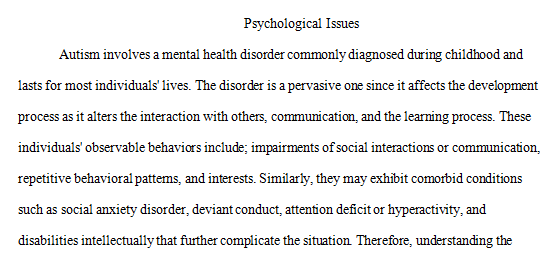
Review this week’s Learning Resources, focusing on the gender-related differences and similarities in issues related to health.
Psychological Issues
Discussion: Physical Health Issues
Biological differences between men and women in areas such as hormones and immune response certainly can contribute to health differences between the sexes, but in order to fully explore their causes, other variables must be examined. An important area to consider when looking at health and gender is behavior. That is, do men and women behave differently when it comes to health? Health-related behaviors fall into two basic categories: preventative behaviors and direct health-related behaviors. For example, seeing a physician for an annual check-up and health screening, eating well, exercising, and maintaining low stress levels are preventative behaviors. Engaging in high-risk sports and smoking are direct health-related behaviors. Gender differences in health behaviors must be interpreted carefully. For example, frequency of doctor visits—which is higher among women—should not necessarily be interpreted as a reliable indicator of higher morbidity in women, since women tend to engage in more preventative health behaviors.
Lastly, gender differences in social roles may contribute to health differences. Physically demanding careers held more often by men may lead to greater health risks such as job-related injury. On the other hand, women’s traditional role as family caretaker can also lead to health risks such as poor self-care and fatigue.
For this Discussion, you will analyze gender-related differences in physical health for a specific health issue of your choosing. You will not only explore its incidence and causes, but will also share potential strategies to mitigate risk.
To prepare
- Review this week’s Learning Resources, focusing on the gender-related differences and similarities in issues related to health.
- Select a physical health issue that interests you that has gender-related differences, and research this health issue using the Walden Library and other reputable academic sources.
- Search the literature for effective strategies to mitigate the risk of the health issue.
Post a brief description of the physical health issue you selected. Then, compare (similarities and differences) the following factors for men and women:
- The incidence, mortality rate, diagnosis, and prognosis of the health issue
- The lifestyle and behavior differences that lead to and/or may prevent the health issue
- Issues related to health care access, diagnosis, and treatment by health care professionals
Finally, provide strategies from the literature that may help to mitigate the risk of this health issue.
Discussion: Psychological Issues
Betty Friedan’s seminal work about social and psychological issues facing some women in the middle of the twentieth century opened with the question she saw as plaguing suburban wives: Is this all? During Friedan’s time, college graduation rates for women were actually dropping compared to the previous generation as postwar World War II economic prosperity led many women to abandon career aspirations in favor of raising families. The Feminine Mystique tells the story of a particular group of women, and as critics are correct to point out, it does not speak for the situation of many women of color and women who were not privileged socioeconomically. It did, however, expose the way that social and psychological factors came together to create gender differences in psychological wellbeing.
In the 21st century, gender differences in morbidity and mortality related to psychological issues still exist. Your course text highlights gender differences in depression, eating disorders, and suicide, but differences exist regarding other issues as well. Antisocial and avoidant personality disorders are more common in men, while borderline and histrionic personality disorders are more often seen in women. While there is some biological evidence for these differences, there is a greater amount of evidence that supports the influence of psychosocial factors related to gender socialization and gender roles themselves.
For this Discussion, you will examine gender differences related to and biopsychosocial causes of a particular psychological issue.
To prepare
- Consider the following three populations and psychological issues and select one to use for this Discussion:
- Autism spectrum disorder among children
- Conduct disorder among adolescents
- Panic disorder among adults
- Search the Library to identify any biopsychosocial risk factors that may contribute to the psychological issue you selected.
- Identify how gender influences prevalence rates, diagnosis, and treatment of this disorder.
Post a description of the issue you selected; identify any biopsychosocial risk factors; and discuss how gender influences prevalence rates, diagnosis, and treatment.
Subject: PHD Psychology
Answer preview…………………………………………….
 apa 671 words
apa 671 words